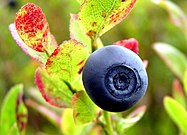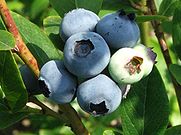Berry
|
A berry is a small, pulpy, and often edible
The common usage of the term "berry" is different from the scientific or
Berries are eaten worldwide and often used in
While many berries are edible, some are
History

Berries have been valuable as a food source for humans since before the start of agriculture, and remain among the primary food sources of other primates. They were a seasonal staple for early hunter-gatherers for thousands of years, and wild berry gathering remains a popular activity in Europe and North America today. In time, humans learned to store berries so that they could be used in the winter. They may be made into fruit preserves, and among Native Americans, mixed with meat and fats as pemmican.[8]
Berries also began to be cultivated in Europe and other countries. Some species of blackberries and raspberries of the genus Rubus have been cultivated since the 17th century, while smooth-skinned blueberries and cranberries of the genus Vaccinium have been cultivated in the United States for over a century.[8] In Japan, between the 10th and 18th centuries, the terms ichibigo and ichigo referred to many berry crops. The most widely cultivated berry of modern times, however, is the strawberry, which is produced globally at twice the amount of all other berry crops combined.[9]
The strawberry was mentioned by ancient Romans, who thought it had medicinal properties,
Etymology
The Old English word berie ("berry, grape,") comes from Proto-Germanic *basjom (source also of Old Norse ber, Middle Dutch bere, German Beere "berry;" Old Saxon winberi, Gothic weinabasi "grape"), which is of unknown origin. This and apple are the only native fruit names.[15]
Botanical definition
Cranberries In stone fruits or drupes
Berries under both definitions include lingonberries, and the fruits of many other members of the heather family, as well as gooseberries, goji berries and elderberries. The fruits of some "currants" (Ribes species), such as blackcurrants, red currants and white currants , are botanical berries, and are treated as horticultural berries (or as soft fruit in the UK), even though their most commonly used names do not include the word "berry".
Botanical berries not commonly known as berries include bananas,[17][18][unreliable source?] tomatoes,[1] grapes, eggplants (aubergines), persimmons, watermelons, and pumpkins. There are several different kinds of fruits which are commonly called berries, but are not botanical berries. juniper berries, used to flavour gin, the cone scales, which are hard and woody in most conifers, are instead soft and fleshy when ripe. The bright red berries of yews consist of a fleshy outgrowth (aril ) almost enclosing the poisonous seed.
Cultivationbrambleberries with desirable traitsStrawberries have been grown in gardens in Europe since the 14th century. are likewise not domesticated, with some being of commercial importance. boreal forest.[23] Agricultural methodsLike most other food crops, berries are commercially grown, with both conventional pest management and Organically certified berries are becoming more widely available.[24] :5
Many soft fruit berries require a period of temperatures between 0 and 10 °C (32 and 50 °F) for breaking dormancy. In general, strawberries require 200–300 hours, blueberries 650–850 hours, blackberries 700 hours, raspberries 800–1700 hours, currants and gooseberries 800–1500 hours, and cranberries 2000 hours. Growing most berries organically requires the use of proper crop rotation, the right mix of cover crops, and the cultivation of the correct beneficial microorganisms in the soil.[33] As blueberries and cranberries thrive in soils that are not hospitable to most other plants, and conventional fertilizers are toxic to them, the primary concern when growing them organically is bird management.[33] Postharvest small fruit berries are generally stored at 90–95% relative humidity and 0 °C (32 °F).[34] Cranberries, however, are frost sensitive, and should be stored at 3 °C (37 °F).[34] Blueberries are the only berries that respond to ethylene, but flavor does not improve after harvest, so they require the same treatment as other berries. Removal of ethylene may reduce disease and spoilage in all berries.[34] Precooling within one to two hours post-harvest to storage temperature, generally 0 °C (32 °F), via forced air cooling increases the storage life of berries by about a third.[34] Under optimum storage conditions, raspberries and blackberries last for two to five days, strawberries 7–10 days, blueberries two to four weeks, and cranberries two to four months.[34] Berries can be shipped under high carbon dioxide or modified atmosphere of 10–15% carbon dioxide for high carbon dioxide or 15–20% carbon dioxide and 5–10% oxygen for a modified atmosphere container to increase shelf life and prevent grey mold rot.[34]  BreedingSeveral discoveries in the science of breeding berries were made in the 18th century by Antoine Nicolas Duchesne in his work on strawberries.[13] In the traditional technique of plant breeding, berries with specific desirable characteristics were chosen and allowed to sexually reproduce with other berries, and offspring with improved traits could then be selected and used for further crossing. Plants may be hybridized with different species within the same genus; hybridization between different genus may also be possible, but more difficult. Breeding may seek to increase the size and yield of the fruit, improve the flavor and quality of its nutrient content, such as antioxidants, expand the harvest season, and produce cultivars with resistance to diseases, tolerance of hot or cold conditions, and other desirable traits.[35] Advancements in molecular biology and genetic engineering allow for a more efficient and better targeted approach in the selection for a desirable genotype, via marker-assisted selection, for example.[36] Genetic modification techniques can also be used for breeding berries.[35] Horticultural soft fruit berriesSome fruit not commonly referred to as berries and not always botanically berries are included by land-grant university extension offices in their guides for berry cultivation, or in guides for identifying local wild edible and non-edible berries. Examples include Pacific crabapples, and prickly pears.[38]
Commercial productionIn the year 2005, there were 1.8 million acres (7,300 square kilometres) of land worldwide cultivating berries, with 6.3 million short tons (5.7 megatonnes) produced.[24]:4 EconomicsIn certain regions, berrypicking can be a large part of the economy, and it is becoming increasingly common for western European countries such as Sweden and Finland to import cheap labor from Thailand or Bulgaria to do the berry picking.[39][40] This practice has come under scrutiny in the past years because of the low wages and poor living standard for the "berry-pickers", as well as the lack of worker safety.[39] In the late 2010s in the US, reduced migration from Mexico and increased minimum wage standards have made finding "stoop-work" labourers to pick the strawberry crop difficult and costly.[41] Phytochemicals and colorOnce Berry colors are due to natural physiological evidence established to date that berry pigments have actual antioxidant or any other functions within the human body.[47] Consequently, it is not permitted to claim that foods containing polyphenols have antioxidant health value on product labels in the United States or Europe.[48][49]
Culinary significanceUse in baked goods Elderberry Berries are commonly used in pies or tarts, such as blueberry pie, blackberry pie, and strawberry pie. Berries are often used in baking, such as blueberry muffins, blackberry muffins, berry cobblers, berry crisps, berry cakes, berry buckles, berry crumb cakes, berry tea cakes, and berry cookies.[50] Berries are commonly incorporated whole into the batter for baking, and care is often taken so as to not burst the berries. Frozen or dried berries may be preferable for some baked berry products.[51][52][53] Fresh berries are also often incorporated into baked berry desserts, sometimes with cream, either as a filling to the dessert or as a topping.[50] BeveragesBerries are often added to water and/or juiced, as in fermented beverage made from berries (grapes). Fruit wines are commonly made out of other berries. In most cases, sugars must be added to the berry juices in the process of Chaptalization to increase the alcohol content of the wine. Examples of fruit wines made from berries include: elderberry wine, strawberry wine, blueberry wine, blackberry wine, redcurrant wine, huckleberry wine, goji wine and cranberry wine.[57][58][59][60] Berries are used in some styles of beer, particularly framboise (made with raspberry) and other fruit lambics .
Dried raisins and sultanas are examples of dried grape berries, and many other commercially important berries are available in dried form.
Fruit preservesBerries are perishable fruits with a short shelf life, and are often preserved by drying, freezing, pickling or making fruit preserves. Berries such as blackberry, blueberry, boysenberry, lingonberry, loganberry,[61] raspberry, and strawberry are often used in jams and jellies. In the United States, Native Americans were "the first to make preserves from blueberries".[62] Other usagesChefs have created quick pickled soft fruit, such as blackberries,[63] strawberries,[64] and blueberries.[65] Strawberries can be battered and quickly fried in a deep fryer.[66][67] Sauces made from berries, such as cranberry sauce, can be frozen until hard, battered, and deep fried.[68] Cranberry sauce is a traditional food item for Thanksgiving, and similar sauces can be made from many other berries such as blueberries, raspberries, blackberries, and huckleberries.[69][70][71][72][73] Cultural significanceDyeingBerries have been used in some cultures for thimbleberry all produce dye colors. These were once used by Native Americans.[76][77] In Hawaii, the native raspberry called 'akala' was used to dye tapa cloth with lavender and pink hues, whereas berries from the dianella lily were used for blue coloration, and berries from the black nightshade were used to produce green coloration.[78]
ResearchBerry consumption is under preliminary research for the potential to improve nutrition and affect chronic diseases.[79][80] A 2016 review found that berry consumption can significantly lower body mass index, low density lipoprotein (LDL) and systolic blood pressure.[80] See also
References
Further reading
External linksLook up berry in Wiktionary, the free dictionary.
|









